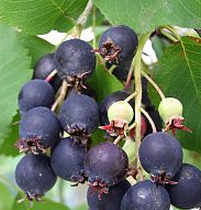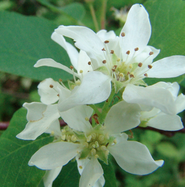 Amelanchier alnifolia, Saskatoon Amelanchier alnifolia, Saskatoon We can think of at least 180 great forest garden & perennial crops for cold climate Sweden. Want to hear about them? Over the course of the next year we will profile 5 a week on the blog. Perennial plants and crops offer a low energy, oil & resource input based foundation for future-proof agricultures. By default if an agriculture is to be called regenerative the bottom line is that it must be soil building, not soil depleting. Relentless deep tillage & poor soil husbandry (wifery?!) contributes to the majority of the 24 billion tons of topsoil lost every year on planet water. We are going to be focused on holistic polyculture grazing and perennial production at ridgedale over most of the site as this represents the most effective way to restore our degraded landscape, produce high value produce and ensure the future resource base we are managing holistically for in our decision making.  Genus Amelanchier Species alnifolia Common Name running juneberry Form shrub Habit clumping Origin North America Light sun Moisture dry to mesic Uses fruit The Amelanchier Genus has 33 species, mostly originating form N America. 6 Species have been found in Sweden, naturalising after cultivation in gardens, and seed spread by birds. The 2 most common here being Amelanchier spicata & Amelanchier confusa. Amelanchier lamarckii & Amelanchier laeves are also common in gardens here in Sweden, and whilst all have edible berries, alnifolia cultivars will be optimal for berry production, with different cultivars being optimal for different regions. It is a deciduous shrub or small tree that can grow to 1–8 m in height. Its growth form spans from suckering and forming colonies to clumped. As with all species in the genus Amelanchier, the flowers are white with 5 quite separate petals as common in rose family (Rosaceae) flowers. The fruit is a small purple pome 5–15 mm in diameter, and in the wild ripening can be irregular which spreads the harvesting over a longer period of time; a trait that can be challenging commercially. Newer cultivars have more even & bountiful cropping. The fruit can be eaten raw or cooked, and tends to ripen in mid summer. It is soft and juicy with a few small seeds in the centre. A very nice sweet flavor that is enjoyed by almost everyone who tries it, there is a hint of apple in the taste. The fruit can also be dried and used as raisins or made into pemmican. The fruit is rich in iron and copper. The leaves are a tea substitute. Saskatoon was quite widely employed as a medicinal herb by the North American Indians, who used it to treat a wide range of minor complaints, although it is little used in modern herbalism. An infusion of the inner bark is used as a treatment for snow-blindness. A decoction of the fruit juice is mildly laxative. It has been used in the treatment of upset stomachs, to restore the appetite in children, it is also applied externally as ear and eye drops. A decoction of the roots has been used in the treatment of colds. It has also been used as a treatment for too frequent menstruation. A strong decoction of the bark was taken immediately after childbirth to hasten the dropping of the placenta. It was said to help clean out and help heal the woman's insides and also to stop her menstrual periods after the birth, thus acting as a form of birth control. Plants have a spreading, suckering root system and are used in windbreaks for erosion control. The wood is hard, straight grained & tough, and is used for tool handles etc. The wood can be made even harder by heating it over a fire and it is easily moulded whilst still hot. The young stems are used to make rims, handles and as a stiffening in basket making. OUR FRIENDS AT PFAF HAVE AN AMAZING DATABASE OF SPECIES (UK BASED);
0 Comments
Leave a Reply. |
Details
Like us on FB Below for regular updatesStay up to date with customized updates you want to receive
Upcoming coursesArchives
December 2016
Categories
All
|

 RSS Feed
RSS Feed